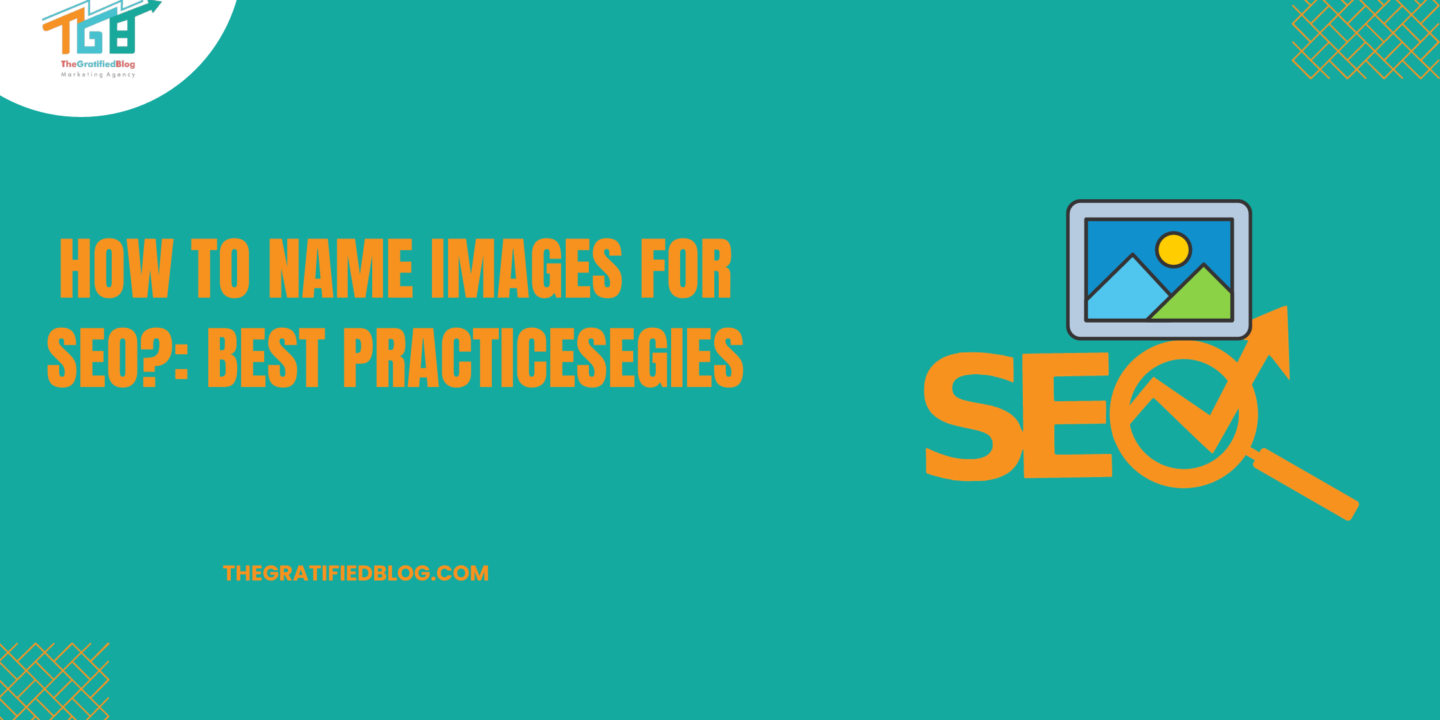
In today’s digital age, where the internet is inundated with many images, mastering the art of optimizing visuals for search engines is more critical than ever, significantly when improving your website’s visibility and attracting organic traffic. To do this effectively, you must pay close attention to a fundamental yet often overlooked aspect of SEO – how to name images for SEO. Yes, you read that correctly! The image file names you choose can significantly impact your website’s performance in search engine results. So, if you’re wondering “How to name images for SEO,” you’ve come to the right place for insights and guidance.
This blog aims to provide an all-encompassing resource, guiding you through various crucial aspects of optimizing images for SEO. We’ll start with an exploration of the impact of image SEO, delve into the essential components of an SEO-friendly image name, address the question of how to name images for SEO effectively, examine the significance of user experience, discuss the connection between image file names and SEO rankings, outline best practices for image SEO, consider methods for measuring its impact, explore frequently asked questions, and finally, draw conclusions.
So, let’s get started:
The Power Of Image SEO
Pictures play a crucial role in online content. They enhance the user experience and provide valuable information and context. However, for search engines, images are just collections of pixels. To understand what an image represents, search engines rely on various clues, including the image’s file name.
When you name your images strategically, you help search engines comprehend your images’ content, which can result in improved search engine rankings and increased organic traffic. Before we dive into optimizing image file names for SEO, let’s first explore the components that constitute an SEO-friendly image name.
The Anatomy Of An SEO-Friendly Image Name
An SEO-friendly image name is descriptive, relevant, and provides context. Here’s what you should consider when naming your images for SEO:
- Descriptive Keywords: Use descriptive keywords that accurately represent the image. If you’re showcasing a picture of a red sports car, don’t name it “IMG_1234.jpg.” Instead, call it “red-sports-car.jpg.”
- Use Hyphens: When separating words in an image when naming files, opt for hyphens (-) rather than underscores or spaces for better recognition by search engines. Recognize hyphens as word separators.
- Keep It Short: While descriptive, keep your image file names concise. Aim for 3-5 words to maintain clarity.
- Include Relevant Keywords: If the image is related to specific content on your website, include relevant keywords that align with the overall SEO strategy.
- Avoid Special Characters: Clear, memorable characters, symbols, or excessive numbers in your image file names. Keep it clean and simple.
Now that you understand the anatomy of an SEO-friendly image name let’s delve into some practical tips and strategies for naming your images effectively.
How To Name Images for SEO?
Keyword Research And Relevance
Start by conducting keyword research to discover relevant keywords that align with your content. This helps in creating image names that are not only descriptive but also closely related to your target keywords.
Uniqueness And Context
Ensure that each image has a unique name that distinguishes it from others on your website. Additionally, incorporate context into the image name, including specific product details if applicable.
Long-Tail Keywords And Location
Utilize long-tail keywords to make your images more specific, improving their chances of appearing in niche search results. If your content is location-specific, include the location in the image name for enhanced local SEO.
Image Format, Numbers, Dates, and Alt Text
Consider the image format when naming it, such as specifying “infographic” for infographic images. If relevant, include numbers or dates in the image name, especially for event-related images. Don’t forget to set appropriate alt text for accessibility, reflecting the image content and its context within the webpage.
With a grasp of how to name images for SEO, let’s now explore the significance of user experience, the relationship between image file names and SEO ranking, best practices for image SEO, and methods to gauge its impact.
The Importance Of User Experience
While the primary goal of naming images for SEO is to enhance search engine visibility, it also significantly impacts user experience. Users searching for images on Google or other search engines often rely on the image file names to decide which ones to click. Therefore, a well-named image can attract more clicks and engagement.
Consider this scenario: A user searches for “modern kitchen design ideas.” They see two images, one named “kitchen.jpg” and the other called “modern-kitchen-design-ideas.jpg.” The latter is more likely to capture their attention and receive more clicks, increasing website traffic.
Additionally, descriptive image names can help users with visual impairments, as screen readers read the image name to provide context. This improves accessibility, a factor that search engines consider in their rankings.
Image File Names And SEO Ranking
Search engines consider various factors in a webpage’s ranking when deciding a. While image file names are just one piece of the puzzle, they contribute to the overall SEO strategy. During the crawling process of your website, search engines examine various on-page elements, including image file names, alt text, and surrounding content. If these elements align with the user’s search intent, it can positively influence your rankings.
Here’s how naming images for SEO can affect your search engine rankings:
- Relevance: Descriptive image names convey to search engines that your content aligns with users’ search queries. This can boost your website’s ranking in search results.
- Click-Through Rate (CTR): As mentioned earlier, well-named images can attract more clicks. A heightened click-through rate signals to search engines that users find your content valuable, potentially improving rankings.
- User Engagement: When users engage with your content, it sends positive signals to search engines. Users spending more time on your pages or interacting with your images can improve your SEO performance.
- Rich Results: Properly named images can also lead to rich results in search engine listings, such as image carousels or featured images, which can further enhance your visibility.
Image SEO Best Practices
To make the most of naming images for SEO, consider these best practices:
- Consistency: Maintain a consistent naming convention for all your pictures. This simplifies the process for search engines to comprehend your content.
- Image Compression: Ensure that your images are appropriately compressed and optimized for the web to improve loading times, which can also impact SEO.
- Image Sitemaps: Include images in your website’s sitemap to help search engines index your images more efficiently.
- Mobile Optimization: Due to a growing number of users accessing the internet on mobile devices, ensure your images are responsive and optimized for various screen sizes.
- Test and Monitor: Regularly assess the performance of your images in search results. If specific images aren’t ranking well, consider revising their names or alt text.
Measuring The Impact
To assess the impact of your image naming strategy, you can use various SEO tools, including Google Search Console. Here, you can monitor the performance of your images in search results and track clicks, impressions, and CTR. Tools like Google Analytics can also provide insights into how image optimization affects user engagement and conversions.
Remember that SEO is ongoing; you may need to refine your image naming strategy over time. Keep an eye on your website’s performance, gather feedback, and adapt to changes in search engine algorithms and user behavior.
FAQs
Q1. Why is it essential to name images for SEO?
A. Naming images for SEO is crucial because it aids search engines in comprehending the content within your images, leading to improved search engine elevated rankings and a boost in organic traffic to your site.
Q2. What are the key elements of an SEO-friendly image name?
A. An SEO-friendly image name should include descriptive keywords, use hyphens to separate words, be concise, include relevant keywords, avoid special characters, and provide context about the image’s content.
Q3. How can keyword research benefit image naming for SEO?
A. Conducting keyword research helps you identify relevant keywords that can be incorporated into your image names. This aligns your images with your overall SEO strategy, making them more discoverable in search results.
Conclusion
In the world of SEO, every detail counts. Image file names may seem minor, but when used strategically, they can significantly impact your website’s visibility and user experience. Following best practices, conducting keyword research, and maintaining a consistent naming convention can enhance your image SEO and overall search engine rankings.
In the digital age, where visuals play a pivotal role in content consumption, optimizing your images for SEO is not a luxury but a necessity. So, whether you’re running a blog, an e-commerce site, or any other type of website, start paying attention to how you name your images and watch your online presence grow.
If you still have any questions related to the blog, then feel free to leave them in the comment section. We will be happy to answer you.
Thanks for reading 🙂








No Comments